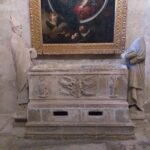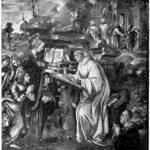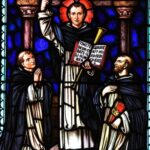St. Peter Canisius
St. Peter Canisius
St. Peter Canisius: A Renaissance Scholar and Spiritual Titan
When they lived:
St. Peter Canisius lived from May 8, 1521, to December 21, 1597.
Where they lived:
Born in Nijmegen, Netherlands, St. Peter Canisius spent most of his life in various regions of Europe, including Germany, Austria, Switzerland, and the Czech Republic.
Notable world events during the time of their life:
- The Council of Trent (1545-1563): This significant event in the history of the Catholic Church aimed to address and reform various issues raised by the Protestant Reformation. St. Peter Canisius, a prominent Jesuit priest, played an essential role in implementing the council’s decrees and promoting Catholic reforms.
- The Age of Exploration (15th-17th centuries): During Canisius’ lifetime, European exploration and colonization expanded rapidly, with explorers like Christopher Columbus, Vasco da Gama, and Ferdinand Magellan making groundbreaking discoveries. This era led to the encounter of different cultures and civilizations, impacting the world’s geopolitical landscape.
- The Scientific Revolution (16th-17th centuries): This period saw groundbreaking advancements in science and mathematics. Renowned figures like Galileo Galilei, Johannes Kepler, and Nicolaus Copernicus challenged the prevailing geocentric model of the universe, paving the way for modern astronomy and physics.
- The Northern European Renaissance (14th-17th centuries): St. Peter Canisius lived during the peak of the Renaissance, a flourishing period of art, literature, and intellectual growth. This cultural movement shaped Europe’s history and brought about immense contributions to the arts and sciences.
- The Battle of Lepanto (1571): This naval battle, fought between the Holy League, a Christian alliance, and the Ottoman Empire, marked a crucial victory for Christianity. St. Peter Canisius played an important role in rallying support for the Holy League and strengthening Europe’s resistance against the Ottoman forces.
Their patronage:
St. Peter Canisius is the patron saint of the Catholic Press, the Catholic press workers, and the Catholic schools in Germany.
Life
Peter’s father was a well-off Burgermeister, and his mother died soon after his birth. He was 19 years old when he went to study at the University of Cologne. He completed his master’s degree there in 1540.
In 1543, Peter met Peter Faber, and through him, he joined the Society of Jesus that was newly established. Under the supervision of Faber, he did spiritual exercises, and soon he decided to become a Jesuit.
He also preached in the city, and he taught in universities because of his recurrent travels between colleges and universities, which were tiring and unsafe at the time. He came to be known as the Second Apostle of Germany.
He had a strong influence on Emperor Ferdinand I. as the king’s son in the office of court preacher appointed Phaser, who was a married priest. Canisius opposed him both verbally and on paper. As a result, the phaser was dismissed. Phaser harbored resentment against Canisius for the rest of his life.
Peter attended many sessions of the Council of Trent. He was a persuasive preacher. He was also offered to be a bishop, which he declined. He wanted to stay as a traveler and continue his teaching and traveling.
In 1557, he moved to Germany, at the Colloquy of Worms, where he continued to be the foremost Catholic theologian. From 1559 to 1568, he served in the Cathedral of Augsburg as a preacher, and after that, he founded the University of Innsbruck in 1562.
After he left Germany, the newly built Society of Jesus became a powerful tool. Canisius spent his last 20 years of life in Fribourg. He made the Jesuits, where young ones trained for university studies for generations.
Work
He published his three catechisms in both Latin and German, which were his lasting contributions, and they were widespread and became popular in the Christian religion.
In 1555, he published his book, Summary of Christian Doctrine, which was written in easy Latin. After a year, in 1556, German was published too.
The same year, his other work, A Tiny Catechism for Children, was published. After two years, An Abridged Catechism, which was his most famous work, was published too.
Death
In 1591, when Canisius was 70 years old, he suffered a stroke that left him partially paralyzed. Despite all that, he still continued his preaching with the help of security until he died in Fribourg. He died at the age of 76 on Dec. 21, 1597.
Canisius was buried at St. Nicholas Church. But later, his remains were transferred to the Jesuit College he founded and the place he had spent his last years. The room that he used during his previous months was also open for reverence.
5 Interesting Facts About St. Peter Canisius
- Canisius’ famous saying is, “If you have too much to do, with
“With God’s help, you will find time to do it all.” - He was known as the Second Apostle of Germany.
- Peter Canisius was known as a profoundly prayerful person and
indefatigable worker. - He traveled about 2000 miles in 1557 through Italy, Austria,
Bavaria and the Rhineland. - Peter Canisius was declared the doctor of the church.
Prayer to St. Peter Canisius
Dear Doctor and Defender of the Church, to you the Master must have said, “Well done, composer of books that have taught and inspired countless persons in many lands.” Help those who compose catechisms to communicate the true teachings of Christ in ways that can be understood by our contemporaries so that they will be moved to follow Jesus. Amen.



